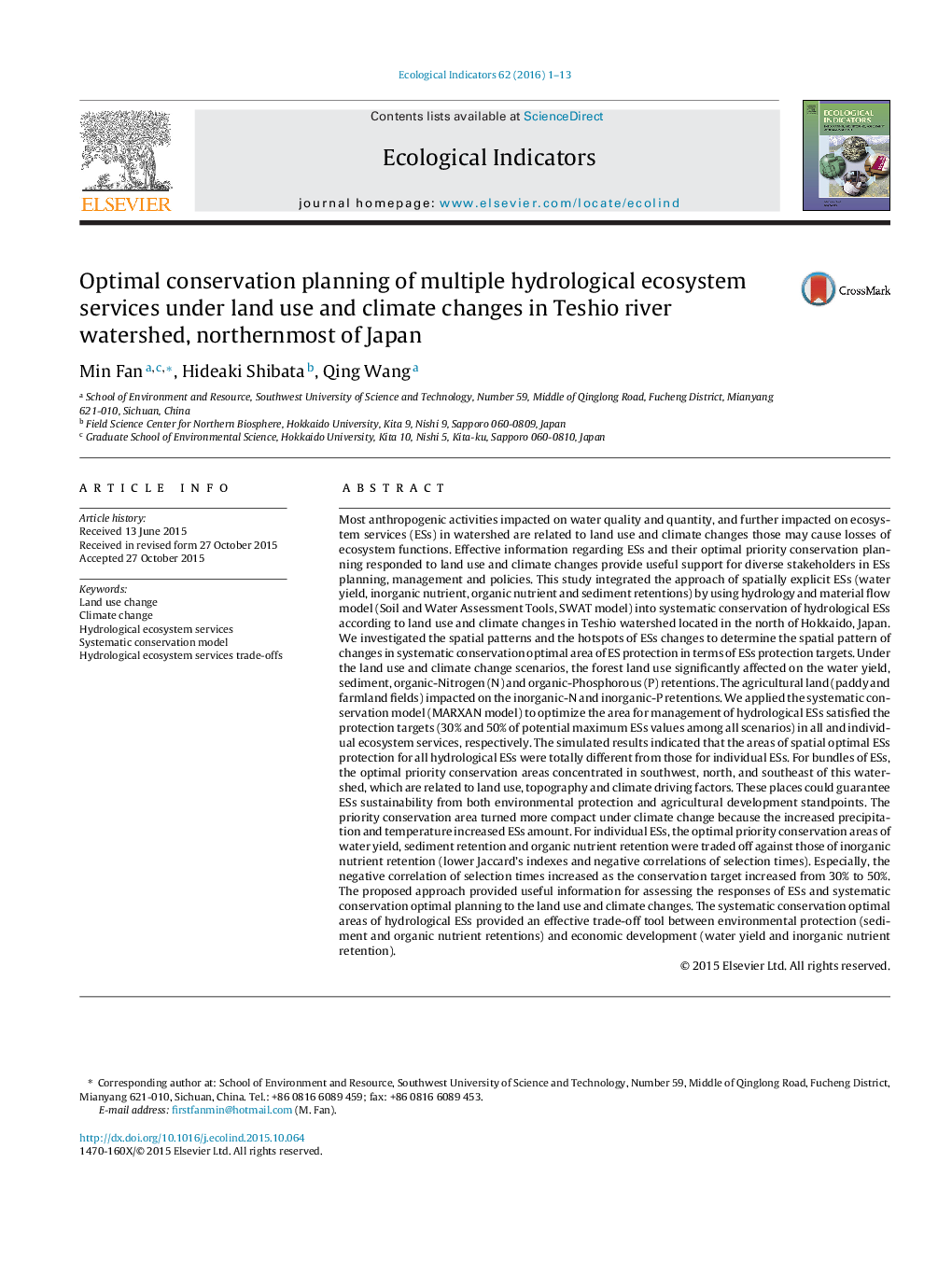| کد مقاله | کد نشریه | سال انتشار | مقاله انگلیسی | نسخه تمام متن |
|---|---|---|---|---|
| 6293911 | 1617140 | 2016 | 13 صفحه PDF | دانلود رایگان |
عنوان انگلیسی مقاله ISI
Optimal conservation planning of multiple hydrological ecosystem services under land use and climate changes in Teshio river watershed, northernmost of Japan
ترجمه فارسی عنوان
برنامه ریزی حفاظت بهینه از خدمات اکوسیستم چند هیدرولوژیکی تحت استفاده از زمین و تغییرات آب و هوایی در حوضه رودخانه تشیو، شمال ژاپن
دانلود مقاله + سفارش ترجمه
دانلود مقاله ISI انگلیسی
رایگان برای ایرانیان
کلمات کلیدی
تغییر کاربری زمین، تغییر آب و هوا، خدمات اکوسیستم هیدرولوژیکی، مدل حفاظت سیستماتیک، هیدرولوژیکی خدمات اکوسیستم،
موضوعات مرتبط
علوم زیستی و بیوفناوری
علوم کشاورزی و بیولوژیک
بوم شناسی، تکامل، رفتار و سامانه شناسی
چکیده انگلیسی
Most anthropogenic activities impacted on water quality and quantity, and further impacted on ecosystem services (ESs) in watershed are related to land use and climate changes those may cause losses of ecosystem functions. Effective information regarding ESs and their optimal priority conservation planning responded to land use and climate changes provide useful support for diverse stakeholders in ESs planning, management and policies. This study integrated the approach of spatially explicit ESs (water yield, inorganic nutrient, organic nutrient and sediment retentions) by using hydrology and material flow model (Soil and Water Assessment Tools, SWAT model) into systematic conservation of hydrological ESs according to land use and climate changes in Teshio watershed located in the north of Hokkaido, Japan. We investigated the spatial patterns and the hotspots of ESs changes to determine the spatial pattern of changes in systematic conservation optimal area of ES protection in terms of ESs protection targets. Under the land use and climate change scenarios, the forest land use significantly affected on the water yield, sediment, organic-Nitrogen (N) and organic-Phosphorous (P) retentions. The agricultural land (paddy and farmland fields) impacted on the inorganic-N and inorganic-P retentions. We applied the systematic conservation model (MARXAN model) to optimize the area for management of hydrological ESs satisfied the protection targets (30% and 50% of potential maximum ESs values among all scenarios) in all and individual ecosystem services, respectively. The simulated results indicated that the areas of spatial optimal ESs protection for all hydrological ESs were totally different from those for individual ESs. For bundles of ESs, the optimal priority conservation areas concentrated in southwest, north, and southeast of this watershed, which are related to land use, topography and climate driving factors. These places could guarantee ESs sustainability from both environmental protection and agricultural development standpoints. The priority conservation area turned more compact under climate change because the increased precipitation and temperature increased ESs amount. For individual ESs, the optimal priority conservation areas of water yield, sediment retention and organic nutrient retention were traded off against those of inorganic nutrient retention (lower Jaccard's indexes and negative correlations of selection times). Especially, the negative correlation of selection times increased as the conservation target increased from 30% to 50%. The proposed approach provided useful information for assessing the responses of ESs and systematic conservation optimal planning to the land use and climate changes. The systematic conservation optimal areas of hydrological ESs provided an effective trade-off tool between environmental protection (sediment and organic nutrient retentions) and economic development (water yield and inorganic nutrient retention).
ناشر
Database: Elsevier - ScienceDirect (ساینس دایرکت)
Journal: Ecological Indicators - Volume 62, March 2016, Pages 1-13
Journal: Ecological Indicators - Volume 62, March 2016, Pages 1-13
نویسندگان
Min Fan, Hideaki Shibata, Qing Wang,
